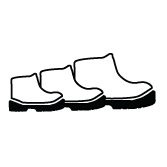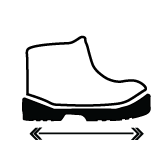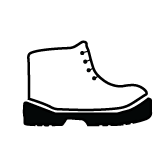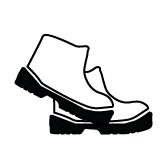
How to Fit Walking Boots
Whether it’s trail walking with the family, a long-distance walk or a mountain hike that you fancy, a pair of good quality walking boots is essential.
Ill-fitting hiking boots can result in blisters and rubbing, ultimately ruining your next outdoor adventure. Instead of enjoying the view around you, you’ll be imagining the moment you can take off your boots and put your feet up.
Below, you'll find our tips for finding the right pair for you.
Fitting Walking Boots: Step by Step
Which Walking Boots?
Before even trying on a pair of boots you have to decide which type you need.
This all comes down to what you plan on doing, as there are different shoes for different terrains.
Planning to climb rocky mountain terrain? Then you’ll need hard-wearing boots with extra ankle support. Sticking to the foot paths? A low walking boot with a good outsole will do you good.
Read More: Guide to Choosing Walking Boots
Prepare for Your Fitting
Next you'll need to prepare correctly for your ‘fitting’.
We recommend wearing a pair of thick hiking socks that you intend to wear whilst you’re walking, this will ensure a correct fit. A good pair of walking socks is VITAL!
Always try walking boots in the morning, our feet tend to expand as the day goes on and you don’t want to buy boots that are too big. This could lead to buying an uncomfortable pair of boots.
If you need insoles, make sure you wear them whilst testing out your boots.

1. What Size Walking Boot Do I Need?
Firstly, you need to figure out your size. Aim for the same size as your usual shoe size, boots shouldn't hurt or pinch when you put them on, if they do they are not the correct shoe for you.
Once you've chosen your size, put both boots on and stand up, let your feet spread out and adjust. If the shoes feel uncomfortable before they’ve been laced up then I would size up, as they will only become more uncomfortable once they’ve been tied up and fastened.

2. Length of the Boot
An important thing to do is to ensure that the boot is the correct length. Make sure the boots are still unlaced and place your feet into the boots until your toes are close to the end of the boots - keep them pointed out and not scrunched.
Do Walking Boots Need to Be a Bigger Size?
Insert your index finger down the back of the boot, there should be enough room to put your finger deep into the boot and wriggle it around. If there isn’t enough room to slide your finger down to the heel or it's very hard to do so, this means that the boot is too short. There needs to be enough room in your boot as your feet are likely to swell on long walks.
If there's too much room to move your finger, a smaller size is needed. If there's too much room the boot will remain loose no matter how tight you tie your laces.

3. Lace the Boot
Once you're happy with the length and overall fit of the boot, you need to lace them up.
Press your heel towards the back of the boot, ensuring your foot is flat, start to tighten up the laces. With a slight amount of pressure, follow the laces up to the top of the boot - don’t forget any eyelets, and don't make them too loose.
If the boot is too small the laces will bulge outwards, and if they’re too big you'll feel the need to tighten them. For more information view our guide on how to lace walking boots.

4. Stand & Shift Your Weight
Once you've laced your boots, stand up. The shoes will be much more supportive and they should feel more snug. There should be enough room for you to move your toes around, if your toes touch the end of your walking boot you should definitely size up.
Roll forward so you are on the balls of your feet, then roll them back onto your heels and repeat this process. Shifting your weight around the boot helps to check the support. Your feet should be held in place and not rise out of the heel cup. If there's any movement then tighten the laces and roll your feet again. Another way to check is to crouch down and bend forward, and look out to see if your heel lifts out of the boot.

5. Feel Around
Use your hands to feel around the boot, make sure your toes aren’t too close to the edge and that your foot is filling the entire boot. There should not be any excessive emptiness/bulging.

6. Walk Around
Whilst you’re still in the shop, make sure you walk around so you can adjust the size if they’re too loose/small. Your heel should not lift up and your toes should be able to move around, if you feel no discomfort or pinching, then these are the boots for you.

7. Purchase
Be sure to try on many different boots so you can compare the fit, there is no point in rushing the process as you want your new walking boots to last a lifetime. Make sure you buy the boots you tried on as you know they are the ones that fit you correctly.
Once you go home try them again, walk around in the house for a couple of hours (as you won’t be able to return them if you go outdoors) to ensure that they are comfortable. If you experience any pain then you can exchange them for a different style, or different size.
Improving the Fit of Your Current Walking Boots
If you own a trusty pair of walking boots you don’t want to replace, there is a variety of footwear accessories that can change the comfort and fit of your current pair of boots.
1. Using a foot bed
Using a foot bed can transform a pair of uncomfortable boots into a pair that feel and perform so much better.
Not only do our foot beds improve comfort and stability of the walking boot, they are also designed specifically to reduce stress on feet and joints, improving poor posture.
Adding a foot bed to an old pair of walking boots will give your foot a better foundation for those long weekend walks.
2. Buy new laces
Buying new laces doesn’t seem like a big change, but once you have replaced your tired old laces you should see the immediate difference.
Adding replacement laces to a pair of walking boots, will improve the friction through your boots eyelets, increasing the tightness of your boots to stopping the shoe from slipping.
3. Try different walking socks
Just like your walking boots, a good pair of walking socks are essential. Wearing the same old pair of socks for every hike or hill climb will eventually take its toll.
Always be sure to check your socks for wear on the sole before every walk, this will stop your foot from slipping in the boot, and also add comfort to your walking boots.
Hopefully after following all of the steps you can find the walking boots of your dreams and you’ll be ready for your next outdoor adventure!
